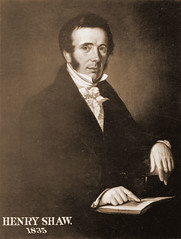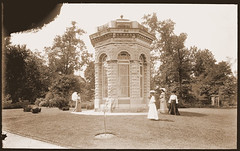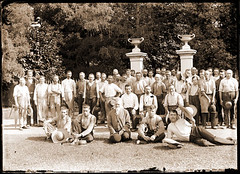
One day in the spring of 1819, 18-year-old Henry Shaw, an Englishman recently landed in the river town of St. Louis on the edge of the American wilderness, took a half-day journey on horseback out of town. Riding westward through marshy ground, past sinkholes and Indian burial mounds, he came at last to a narrow path cutting through brush, and found himself on elevated ground overlooking a prairie. “Uncultivated,” he recorded, “without trees or fences, but covered with tall luxuriant grass, undulated by the gentle breeze of spring.”
If ever a man loved a piece of ground, it was Shaw. As Shaw’s fortunes grew, he resolved to return something to his adopted city, and 40 years after his arrival in St. Louis, he opened on the land he so loved a botanical garden for the city’s residents. This garden is today the Missouri Botanical Garden. One of the oldest botanical gardens in the U.S., Missouri Botanical Garden is outstanding not only in the excellence of its displays, but also in the richness of its architectural heritage and the importance of its botanical research.
Garden founder Henry Shaw came to St. Louis in 1819 to open a business selling hardware and cutlery. As St. Louis flourished in the second quarter of the 19th century, and the city’s population grew, Shaw’s business expanded to include investments in agricultural commodities, mining, real estate and furs.

Shaw’s business success provided him with a substantial fortune and allowed him to retire in 1840 at the age of 39. During the next decade he traveled extensively in the United States and Europe and continued buying property. His eventual holdings of about 1,000 acres included the land he had seen his first year in St. Louis. On this land he had a country home built which would become known as Tower Grove House.
Shortly after his last trip abroad in 1851 where he viewed the Great Exhibition and walked the magnificent grounds of Chatsworth, Shaw began development of the property surrounding his country home, inspired to give the people of St. Louis a garden like the great gardens and estates of Europe. His unusual gesture presaged the age of American philanthropy and the creation of the great U.S. public parks by several decades. Through his acts of philanthropy Shaw provided a great deal of support to develop many other St. Louis institutions in including Tower Grove Park, the Missouri Historical Society, and the St. Louis Mercantile Library.

The news that Henry Shaw was building a botanical garden reached Dr. George Engelmann, a German physician-botanist who had come to the U.S. several decades earlier. Engelmann, one of the great early American botanists, suggested that the garden be more than a public park, that it become involved with scientific work like the great botanical institutions of Europe. With the assistance of Harvard botanist Asa Gray and Sir William Hooker, director of the Royal Botanic Gardens at Kew, near London, Engelmann persuaded Shaw to include a herbarium (collection of botanical specimens) and a library in his garden. Shaw in turn encouraged Engelmann to buy specimens and books in Europe.
The Missouri Botanical Garden opened to the public in 1859 and began to grow in the European tradition of horticultural display combined with education and the search for new knowledge. Today, 153 years after opening, the Missouri Botanical Garden is a National Historic Landmark and a center for science and conservation, education and horticultural display.
Text by Joseph M. Schuster (except last paragraph). Reprinted by permission from Garden, January-February 1983, the publication of The Garden Society, a Division of The New York Botanical Garden.